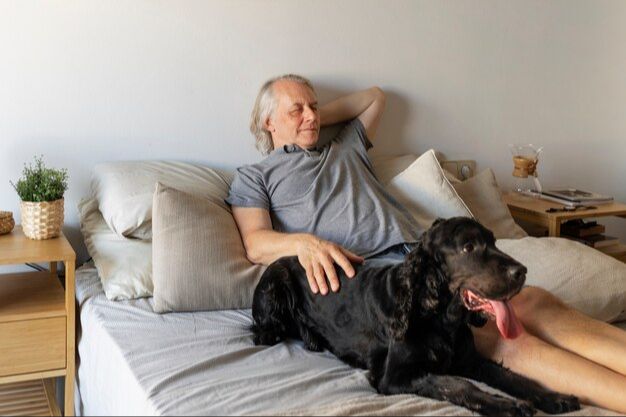Where Dogs Choose to Sit Tells Us About Their Comfort and Preferences
We’ve all seen dogs sitting in some peculiar spots around the house. Our canine companions will plop down on a cozy dog bed, sprawl out on the cool kitchen tiles, or curl up in the corner of a closet. Most dogs have favorite places they habitually return to when it’s time for a sit and a rest.
A dog’s sitting location provides insight into their comfort, personality, breed traits, and health. The exact spot a pooch picks and the position they take can reveal useful information for pet owners. This article will explore the meaning behind where dogs sit, examining the reasons behind their choices and what it indicates about their wellbeing.
Reasons Dogs Choose Particular Spots
Dogs often choose their sitting spot based on feelings of security, comfort, and the ability to survey their surroundings. Here are some of the main reasons dogs may prefer certain locations:
Security/Safety – Dogs naturally want to feel protected and safe. They often choose spots against walls, in corners, or next to furniture that makes them feel less exposed or vulnerable. Sitting with their back protected gives them a sense of security.
Comfort – Soft, cushioned surfaces like dog beds, rugs, or sofas provide more comfort for sitting and resting. Dogs may choose these spots to avoid sitting on cold, hard floors that can strain their joints over time. Comfortable spots allow them to fully relax.
Ability to Survey Surroundings – Dogs like to observe all activity going on around them. Elevated spots or positions with a clear vantage point allow a dog to see anyone approaching or any action in the home. This gives them a sense of control and awareness.
Favorite Locations and Positions
Dogs have particular favorite spots where they love to sit and specific positions they prefer. One of the top places dogs choose to sit is right on or near their owner. Dogs are pack animals and see their family as part of their pack, so they like to remain close whether the owner is on the couch, at a table, or even on the floor. If the dog can’t sit directly touching the owner, they will often sit as close as possible, such as at their feet.
Another prime spot dogs choose is anywhere sunny. Dogs love basking in the warm sunbeams streaming through a window or door. They will happily sit in a bright patch of sunlight for hours soaking up the rays. This likely connects to their ancestry, as wolves and wild dogs would sleep and rest in sunny areas to stay warm.

Elevated areas or high vantage points are also preferential sitting spots for many dogs. They seem to like sitting on surfaces above ground level so they can easily survey their surroundings. Examples are a dog who always sits on the back of the couch, or one who sits on the top step of a stairwell. These positions allow them to observe what’s happening and see any activity going on nearby.
Breed Differences
Different dog breeds have their own characteristic sitting preferences and habits. Herding breeds, such as collies, German shepherds, and Australian shepherds, often prefer to sit up high so they can survey their surroundings. Their instinct to watch over a flock leads them to perch on furniture, steps, or hills where they can see what’s happening nearby. On the other hand, lap dogs like Chihuahuas, toy poodles, and Cavalier King Charles spaniels prefer to sit right next to their owners for comfort and affection. Their small size allows them to snuggle cozily on a person’s lap. Understanding what sitting spots appeal most to a dog’s breed can help owners provide suitable locations around the home and yard.
What Sitting Position Indicates
The way a dog sits and the position it chooses can provide insight into its mood and personality. Some key things to look for include whether the dog sits with its legs curled underneath or stretched out in front, as well as the position of its head and tail.
Dogs that sit with their legs curled underneath tend to feel more relaxed and comfortable. This tucked position is soothing and allows them to easily spring into action. Sitting with legs stretched out in front is also a relaxed position but shows a more confident pooch.
A dog that sits with its head held high and ears perked is indicating alertness and attentiveness to its surroundings. A lowered head with relaxed ears demonstrates a more mellow mood.

Tail position also conveys a lot about a dog’s state of mind. A tail held vertically signals confidence and interest, while a loosely wagging or lowered tail shows contentment and tranquility. An anxious or nervous dog may hold its tail tucked snugly between its legs.
Paying attention to a dog’s sitting posture provides a window into how it’s feeling. With experience, dog owners can learn to interpret their best friend’s unspoken body language.
Impact on Joints and Health
The surface where a dog chooses to sit can have an impact on their joint and musculoskeletal health. Hard surfaces like tile, wood floors, or concrete put more pressure on a dog’s joints than soft surfaces like dog beds, pillows, grass, or carpet.
Dogs that consistently sit on hard surfaces are at higher risk for developing joint problems like arthritis and hip dysplasia as they age. The hardness of the surface puts more strain on joints and can wear down cartilage over time. Sitting on soft surfaces helps absorb pressure and reduces joint impact.
Owners of dogs prone to arthritis should provide soft dog beds around the house and limit time sitting on hard floors. Providing pad cushions is another way to make hard surfaces gentler for arthritic pets. Avoiding hard surfaces can help reduce inflammation and discomfort, especially for senior dogs.
In addition to surface type, the position a dog sits in also impacts their joints. Sitting with hip or knee joints tightly bent for long periods can increase pressure. Allowing space for joints to extend helps take pressure off. Owners can promote better sitting positions by placing raised dog beds that allow legs to extend rather than tuck underneath.
Training a ‘Sit’
Teaching your dog to sit on command is an important building block for further training. There are two main methods for training a reliable ‘sit’:
Luring Method
The luring method takes advantage of your dog’s natural instinct to follow a treat or toy lure. Hold the lure right above your dog’s nose, then slowly move it back between their ears while saying “sit”. Their head will follow the lure upwards and back, causing their hindquarters to lower into a sit position. Reward with the lure when they sit. Repeat this process until they reliably sit when you give the verbal cue without needing the lure.

Capturing Method
The capturing method simply rewards your dog for offering the desired behavior on their own. Wait until your dog sits, then immediately reward them and pair it with the “sit” verbal cue. Only say the cue as the behavior is happening so your dog learns to associate the word with the action. Continue rewarding every time they sit to reinforce the behavior. Eventually they will sit reliably on just the verbal cue.
Choose the method that works best for your individual dog’s personality and learning style. With patience and consistency using either approach, you can teach a solid sit command that will be the basis for further skills.
Modifying Unwanted Sitting
If your dog consistently sits in an area you’d rather they avoid, there are some simple training techniques you can use to encourage them to choose a different spot instead. The key is to block access to the undesirable location while rewarding them for sitting where you want them to.
Use baby gates, furniture, or other barriers to prevent access to problem areas like next to the front door, on your favorite spot on the couch, or in high-traffic zones. Shut doors or close off rooms if needed. This removes the option to sit where you don’t want.
At the same time, attract your dog to the right area by placing a comfortable dog bed, mat, or towel in the preferred spot. Reward them with treats and praise every time they sit there. You can even practice the ‘sit’ command by having them go to the spot and sit on cue. Be consistent, and they’ll learn that’s the place for sitting.
With this positive reinforcement training, your dog will change their habits. Soon they’ll automatically go to the spot you’ve set up for them when they want to sit or lie down. Don’t allow access to the unwanted areas until they’ve fully learned the new rules.
Providing the Right Spots
There are two main ways to provide ideal spots for your dog to sit in the house:
One option is comfortable dog beds. Look for beds with ample padding and cushiness, especially for older dogs with joint issues. Orthopedic beds are perfect for elderly or arthritic pups. Beds with bolsters, such as nest-style beds, make good sitting spots too because dogs can lean against the sides. Place dog beds in locations where your dog already likes to sit. This gives them an inviting alternative to the hard floor or ground.
Another good spot for dogs to sit is window perches. These are like cushioned platforms raised just high enough for your dog to see outside. Perches allow pups to gaze out the window while seated comfortably. Look for perches with good back support and non-slip surfaces. Position them in front of windows that your dog shows interest in, like near the front door or facing the backyard.
Providing designated areas for sitting prevents dogs from always lying on cold, hard floors that can aggravate joint issues. Dog beds and perches give them soft, cushioned spots to take the weight off their joints.

Conclusion
The location and position a dog chooses to sit in provides insight into their comfort, preferences, and personality. Certain breeds are prone to sitting in particular ways based on body structure, while individual dogs may favor specific spots in a home or yard based on familiarity and security. While it’s fine to train dogs to sit on command, it’s also important to let them choose their sitting spots organically as much as possible. Allowing dogs self-determination in sitting location and position promotes joint health for the long term and respects their autonomy and instincts.
In conclusion, careful observation of where and how dogs choose to sit gives owners a window into their canine companions’ minds. Making sure to provide a variety of soft, supportive surfaces for sitting can lead to better joint health. Balancing training with free choice encourages a dog’s natural preferences. Paying attention to what spots and positions your dog is drawn to will deepen your bond and help them feel secure.